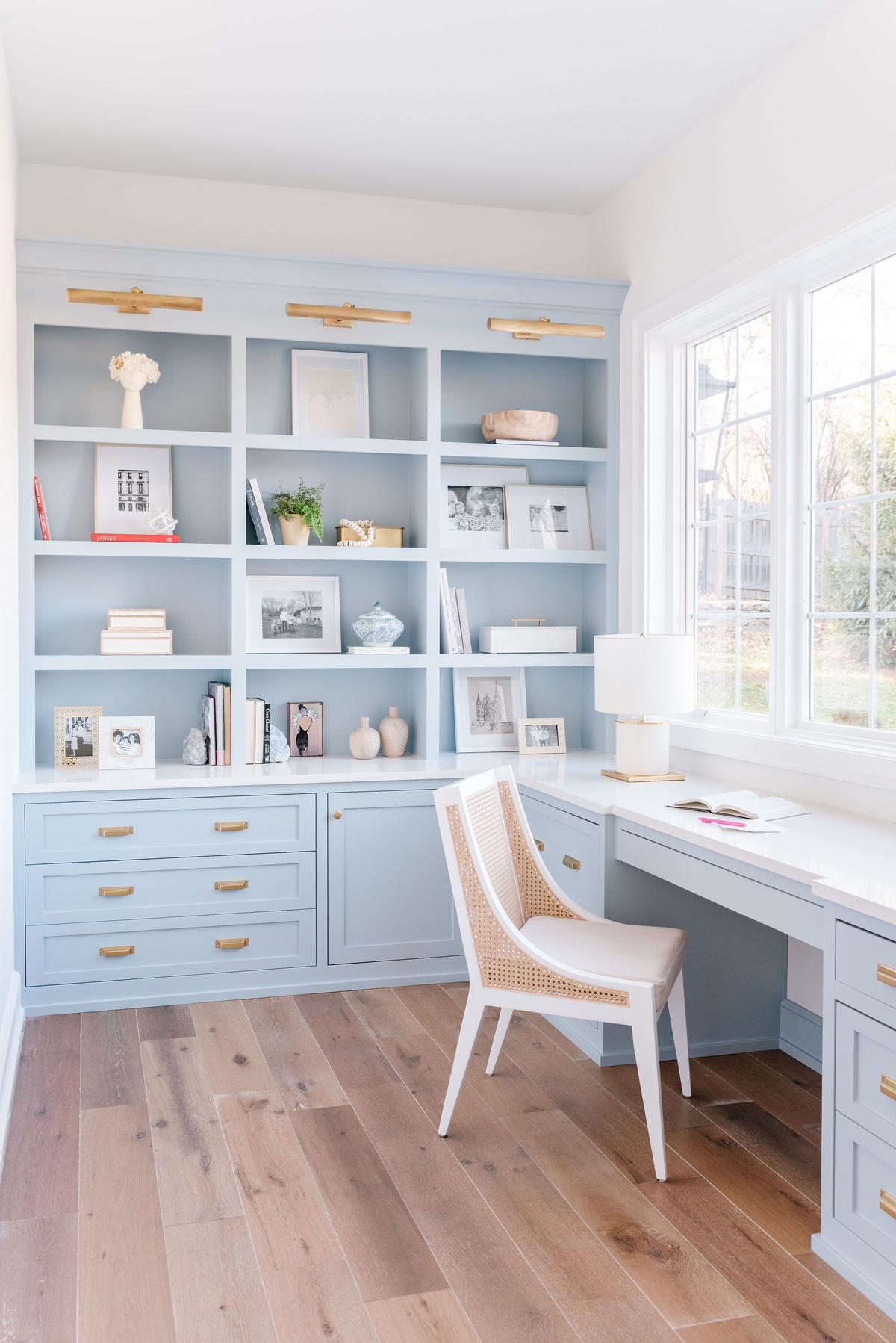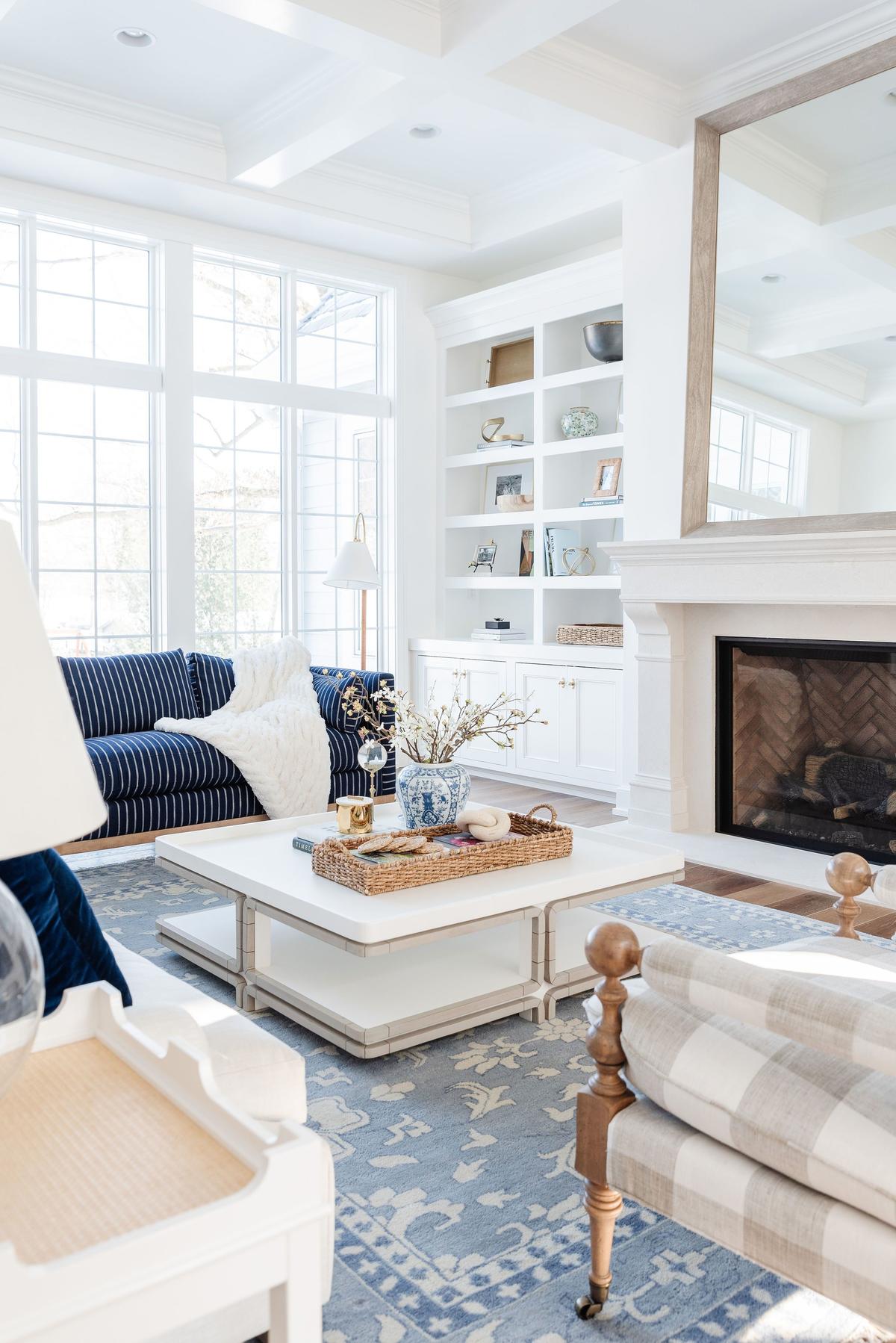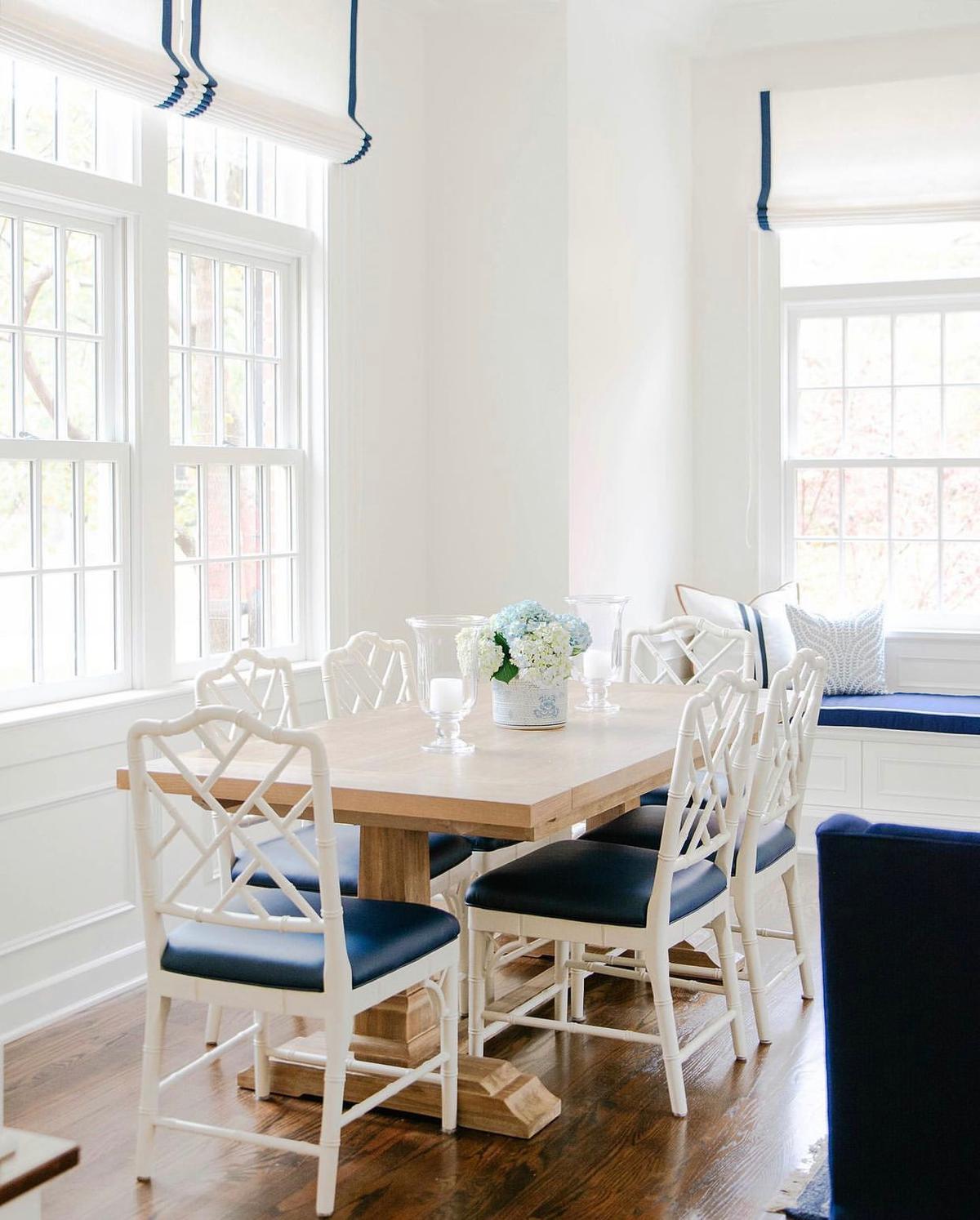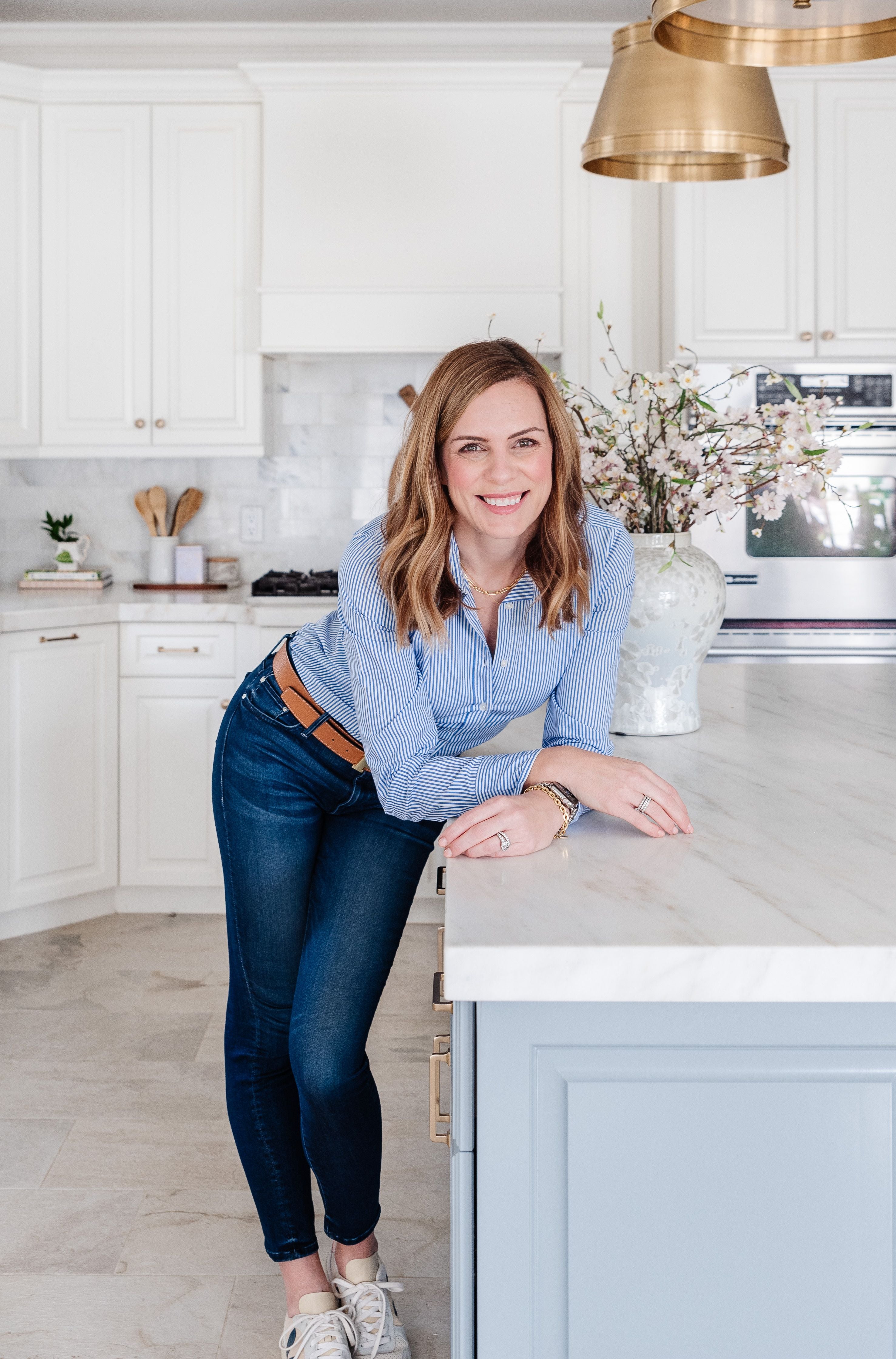The 50 States Project is a yearlong series of candid conversations with interior designers across the country about how they’ve built their businesses. This week, Omaha, Nebraska–based Erica Bryant tells us why she loves remodeling projects, how she manages not having a dedicated office space, and why she stopped following trends.
What was the moment you realized that a career in design was what you wanted to pursue?
Not too long ago, I stumbled upon my eighth grade yearbook, and my class said that I was most likely to become an interior decorator. But then, of course, life takes its twists and turns. I was actually an advertising major, and did print advertising right out of college. I started out in print for a small company, and then I moved to radio, working on spots and commercials for local businesses. I had dreams of going to New York—advertising in Nebraska just isn’t quite as exciting—but my fiancé’s job was here, so we never went. Then I got married, had kids and stayed home for a while with my babies.
What pulled you back into design?
We built our first house. Then we renovated our second house. I was always into the “house thing,” and I would go on vacation and spend my time in home stores. As my kids started getting a little bit older, I was antsy to do something creative. I was talking to this builder and remodeler who knew my husband, asking him about his business and if he had somebody [on his team] who picked out selections for clients. He said, “No, but do you want to do it?” And I was like, “Oh, my gosh, yes—but don’t you want somebody with experience?” And he’s like, “It sure sounds like you have plenty of experience.”
So about 11 years ago, that’s what I did. I helped his clients pick out all their selections, and I absolutely loved it. I did it backwards back then, though—I would take a client to a showroom and spend hours with them. We’d look through every faucet or every piece of tile until we picked the right thing.
Then the stars aligned: One day, I got a phone call from this really big builder in town, and he said, “I got your name from one of the local vendors. Would you want to do my Street of Dreams house?” That’s [a house walk of] all of the bigger new construction houses that are selected for this neighborhood tour. It’s a big deal here. And I would not have even considered myself a designer at that time—I was a selection manager, maybe. But I said yes—because why not? I took this entire 5,000-square-foot house and did it.
So you started with the selections, but then you also did all the designs?
Yes—but first I had to go back and tell my employer. It made me realize that I wanted to go out on my own, and that was when I started my own company. It’s crazy, because I don’t think most designers get to start out with a showhouse. I got really lucky.

Showhouses can often be a quicker turnaround than a project for a client. What was the timeline for something like that?
The builder hired me when it was being framed, and I think I worked on that project for about seven months. Plus, I was still doing work as a subcontractor for the first remodeler I worked for, so I had a few projects going on. I did a few more Street of Dreams houses after that, which was great because it gave me credibility and created my portfolio.
How long did it take to gain traction?
Some people would come into those homes, take my business card and call me. I did a few projects for people that came from those leads. After that, all of my business came through word-of-mouth. I just slowly grew my business every year. It started with maybe a house and a couple of small remodel projects at a time.
What does it look like today?
Now I’m to the point where I do a few new builds a year and have really homed in on the remodel business. I do lots of kitchens, master baths, full main floors and basements. I love the challenges that a remodel brings—and I love that when people remodel, they typically have a vision down to the very last accessory. Sometimes in a new build, people are so overwhelmed that by the time the house is complete, they’re like, “Let’s just do one room at a time.”
Right now, I have five very large projects, but I am usually working on 10 to 12 at a time. I’m at the point now where I have a waiting list. I’m not even really taking new clients until next year.
That’s amazing. What kind of team do you have behind you?
A couple years ago, I hired an operations manager. That was my first hire.
So for the first decade, you were doing all of this yourself?
Yes. I felt like I wanted to be a designer, not a manager. Now I also have a design assistant.
When you made that first hire, what did that operations manager take off your plate?
When you own your company, so much of your time is spent on the business side, but I wanted [to focus] on the design side just as much. She really helps me stay organized behind the scenes—doing invoicing, billing, meeting with subcontractors, and helping with ordering, receiving and scheduling deliveries.
How did you know that was the role you wanted to hire for?
Because that’s what took up most of my time and woke me up in the middle of the night.
That’s a great reason. And when you brought on a design assistant, what did that allow you to hand off?
She helps with a lot of the presentations and puts my ideas onto boards. She helps with grabbing samples and organizing presentations and selections. She puts together all of the selection sheets for each vendor on what we’ve chosen for each project. She’s great, and she has great style. Many times, she’ll say the exact same thing I’m thinking, so it’s wonderful.
I hired her right before COVID. I honestly felt terrible, because I thought, “What am I going to do? What if we don’t have any work?” But we’ve been so busy.

Are you in a place where you’re having to turn away some work or say no to jobs? How do you decide what you say yes to?
That’s the most difficult thing in every aspect of my life. I am terrible at saying no—I’m a people pleaser, and I want to do it all, but I’ve realized that it does nobody any good if my plate is too full. I decided recently that I had to start saying no, but a lot of parameters come with that. Usually, if it’s a really close referral, I don’t say no—I’m just honest about my time frame.
Because of your relationship with the referring client?
Yes, exactly. I hold my clients so dear to me—they’re like my best friends by the time we’re done with the project, and their referral means so much to me. I think if they are trusting me with their close friend or family, then I owe it to them to make time. I also don’t want anyone to think that their project isn’t good enough. And sometimes people just don’t articulate what they really need. I’ve said yes to projects that I thought were just going to be really small, and they ended up being the most amazing creative process ever, and if I had said no because I thought all they wanted me to do was bring in some throw pillows and a piece of art, this would have been a missed opportunity. I love my job so much, so I would love to touch each and every house. But it wouldn’t do my current clients any good if I was just doing half-efforts everywhere.
If it’s a project where I’m not starting from the beginning—if somebody says to me, “I’d love help with the finishing of the space”—that’s an easier one for me to say no to, because those are complicated. For me, it’s a process from the beginning to the end. If I’m not part of those beginning steps, it’s hard for me to jump in. If I have to say no to a project, I always give them the name of another local designer, and I think that they would do the same for me. Omaha is a very small community, so I run into people often, and it’s really nice to be able to make a connection.
How have you approached billing for your work?
I started off hourly, but as I became more hands-on, it just became too complicated to figure out how many hours I was spending on each project. If I’m essentially acting as the general contractor or overseeing a project, I charge a percentage above cost. If I’m doing more consulting, then I will bill hourly, plus a percentage above cost for products.
And those percentages are different?
Yes, depending on the scope of the project and if it’s mostly furniture, or if it’s also construction goods. I’ve never had anyone give me pushback on that—though I did have a vendor tell me one time that maybe that’s because I’m not charging enough.
That’s funny. I mean—are you charging enough? Has the business always been profitable?
My business has always been profitable, because I never started off with overhead. I didn’t ever start off with an office or employees. I didn’t have all that to worry about, and that is also another reason why I really had to keep my business small. I have four children, and I didn’t ever want to feel like I was having to manage books and make sure that my employees were being paid and I was overseeing all of their work.

Do you have an office space now?
No, we’re all remote. I’ve always worked out of my house, and I have a space where I can meet with my employees. I’ve wondered what an office space would do for my business—when I meet with clients, it’s always at a showroom or the job site.
Do you take clients to showrooms often?
That has evolved. I used to spend all day taking clients to showrooms, but now we put together a design board for each space. They tell me yes or no, and I keep showing them options until we get it right. Every once in a while, I will take a client to different showrooms for plumbing or lighting or flooring, but for the most part, we work so closely that I know what they want.
Do some clients still need to experience the furniture, and is there an opportunity locally to do that?
Furniture is a whole other story. When we are doing living rooms, most people want to sit on sofas and chairs. I will source the furniture, and then there are a few local showrooms that have pieces on their floor, so I’ll take my clients there and have them touch, feel and sit. Then I’ll show them the fabric selections for that piece and we place the order.
And even if the local showrooms don’t have the items [I’ve specified], I’ve always sat in those pieces previously at High Point Market or placed those pieces in a previous client’s home.
Where do you see the most opportunity to grow your business?
I’m at the point where I am turning business away, and I have made a conscious decision to not grow in numbers. I want my clients to know that when they are booking me, I am going to be doing their project. So where I want to continue to grow is in the quality of projects. We also keep streamlining behind the scenes to make time for more projects or bigger projects, depending on what comes through.
Tell me a little bit about the design scene in Omaha right now.
Everything is happening right now. I follow so many local designers on Instagram, and it is so apparent that there’s so much business for everybody here.
Most of my clients are growing families or families transitioning into having older children, and they see their space differently now than they did when they were first married or had young kids. They are wanting a little more sophistication but still very comfortable and approachable spaces. I have done several historical homes in one of our historical neighborhoods here in town, including some that are on the National Register [of Historic Places]. Those are really fun because your intention is [make sure your changes are in step] with the age of the home. A lot of my remodels are houses that were built in the 1950s and 1960s. They’re just ready for a face-lift—maybe a small addition, a new kitchen, moving the laundry, and making space for a mudroom.

When you look back, what is the biggest thing that you wish you would have known when you were starting your firm?
I would say to stay true to yourself and your design instincts. Don’t follow the trends or think you need to stay in line with a couple of famous designers.
Did you feel pressured to follow the trends early on?
Yes, when I was first being hired. I thought I had to be the first person to show what was new and cool—new colors, new lights—but really, that’s not what people want. They want what works best within their home and for their family. That’s given me the opportunity to not even really pay attention to trends. If it’s new to them and it works for their home—that is really what I built my business around.
Do clients think they want trends when they first come to you?
I think the beauty of Instagram is that people see my portfolio at their fingertips—I don’t have to bring my portfolio to show them, like I used to do for my first meetings. When they hire me, they’ve already decided that they are comfortable with where I will take their projects.
When did that start happening?
Three or four years ago, when I started having my projects professionally photographed. Before that, I mostly just took pictures on my phone or on a DSLR camera, tried to brighten them up and then put them on Instagram.
I was really fortunate to do this large historical home, and I wanted every single piece of that in my portfolio. It was a really large project, so I knew I could not photograph it on my own. At the same time, I had a project for [an] influencer in town who was good friends with [local photographer] Mandy McGregor. We were at a function where I met Mandy, and it was the best day ever. She has done every single one of my projects since then.
And that changed clients’ understanding of what working with you would be like?
Mandy’s photographs really make my projects come to life—it’s like they just bounce off the Instagram feed. Once I started hiring her and making a bigger effort to use Instagram to showcase my portfolio, I’ve noticed that people know what to expect out of my work. They’ve seen it, and there’s a place they can go to and say, “I love this, this and this.”
That’s a really cool turning point. Did you expect that change, or did it surprise you?
It really surprised me. You know, I always say that when I leave a project, it’s the saddest day. But now, because I have these photographs, those projects are always with me.
To learn more about Erica Bryant, visit her website or find her on Instagram.





























